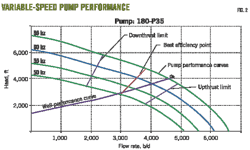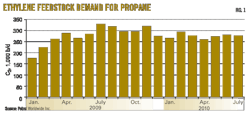Gasoline produced in a fluid catalytic cracking unit has elevated octane rating, but its olefinic structure makes it less chemically stable than other gasoline components. Olefins in gasoline are responsible for formation of polymeric deposits in storage tanks, fuel ducts, and injectors.
Because FCC gasoline contains unstable compounds, Saudi Aramco undertook to study the consequences of long-term storage of such products with olefin content up to 15 vol %. The most sensitive parameters were monitored: oxidation stability, octane number, and existent gum.1
It is important to note that if the gasoline quality breaks down, results from these key tests will be severely affected. To assess the effects of different storage conditions on its quality, the study monitored gasolines from two different refineries over 2 years.
The studies revealed, in part, that the two refineries' gasolines containing 15% olefin when treated with 20 ppm antioxidant can be stored for 2 years.
Aging
Long-term and strategic storage of gasoline is necessary to meet demand in critical times (war, refinery shutdowns, unusual or seasonal market demand) or to adjust to market economics (price hedging). Gasoline starts aging from the minute it is produced, but the rate of aging in FCC gasoline exceeds that for straight-run types because of its high olefins content (unsaturated and highly reactive compounds).
Typical maximum storage time for bulk gasoline worldwide is 6 months, but the ability to extend this period will yield many logistical and financial advantages.
Saudi Aramco's Research and Development Center has assessed the feasibility of storing FCC-based gasoline for 2 years. The center has developed a plan to conduct comprehensive testing for FCC gasoline with in-house accelerated tests, as well as through the use of on site field testing. Blends of different concentrations of antioxidant additives and olefin content were prepared and tested for the parameters that are most affected by long-term storage.
Several blends were prepared and examined monthly for any signs of degradation. This on site field study was conducted simultaneously at an experimental testing site. In-house testing conducted at the center exposed the gasoline blends to 43° C. while also evaluating degradation characteristics.
Another factor that can affect the stability of the stored gasoline is the involvement of compounds containing hetero atoms in deposit formation. Sulfur, nitrogen, and oxygen compounds are found in petroleum.
Sulfur, the most abundant of these elements in gasoline is limited to 0.01% in most commercial specifications. This limit is in place to minimize engine corrosion. It is evident that some sulfur compounds, such as disulfides and thiols enhance the deposit formation as the temperature increases.
The amount of nitrogen and oxygen compounds is not limited but both are assumed to be low in petroleum-derived gasoline.2
Any mechanism proposed for deposit formation must address three key facts:
1. Dissolved oxygen reacts with fuel components and sets up a sequence of reactions that lead to deposit formation.
2. Compounds containing oxygen, sulfur, nitrogen, and metals are major contributors to deposit formation.
3. A minuscule portion of the fuel, less than 0.1 ppm, ends up as detrimental, insoluble material.
A possible mechanism that recognizes these three factors is simplified to two steps.
In the first step, fuel hydrocarbons, including olefins and oxygen, react under catalysis of metal to form oxidized but soluble intermediates.
The intermediate is then combined with minor constituents, primarily sulfur and nitrogen compounds, to form insolubles.2
Antioxidants are used to minimize the effect or to slow deposit formation. These antioxidants prevent oxidation of the fuel interrupting the chain in free-radical chain reaction by blocking the free radicals. Phenylenediamines are the most commonly used antioxidants.3
Experimental
Long-term storage tanks are used to store refined products (diesel, gasoline, and jet fuel) for strategic purposes. Current practice is to store treated gasoline for 2 years.
One of the critical storage specifications for gasoline is its olefin content, which must be 3% maximum. Gasoline produced by an FCC unit frequently contains more than 20 vol % olefins.
The objective of this research was to study the stability of FCC gasolines with varying olefin content and antioxidants for a maximum 2 years. The study was performed on two different blends (Blend 1 and Blend 2) of FCC gasoline having a research octane number of 95.
Determination of the maximum storage life of gasoline depends mainly on storage conditions (storage tank materials; contaminants in storage tanks—water, bacteria, and sediments; oxygen deficiency—availability of positive nitrogen blanket at all times; and storage tank temperature) and gasoline chemical composition (olefins content and specialty chemicals added).
Reactions of the unsaturated hydrocarbons may produce gums, which can be catalyzed by such metals such as copper and nickel. Therefore, antioxidants and metal deactivators are added when gasoline is to be stored for long term.4
This study assumes that excellent storage conditions are in use at all tanks to meet or exceed the same conditions that have been applied in the experimental testing site's tanks. To measure the validity of storing FCC gasoline up to the required period (2 years), the study monitored gasoline quality parameters that specifically indicate a quality perseverance or deterioration of the fuel. It should be noted that this study was performed to monitor the "trend" of quality change and not the specifications (Fig. 1).
36 blends
The study was divided into two main sections: on site testing tanks and in-house accelerated study. Thirty-six blends were prepared and tested in the center; the following parameters were monitored:
1. Fuel oxidation stability. Standard test method for oxidation stability of gasoline-induction period method (ASTM D-525).
2. Fuel gum content. Standard test method for existing gum in fuels by jet evaporation (ASTM D-381).
3. Knock characteristics. Standard test method for research octane number of spark-ignition engine fuel (ASTM D-2699).
For long-term gasoline storage, up to 6 months, the acceptable olefin content is 3 vol % maximum worldwide. It was decided to monitor gasolines containing up to 15 vol % olefins.
It is important to note that if the gasoline quality breaks down, the results of the key tests will be affected severely. In this study, the main concern was compliance with the previously mentioned gasoline quality measures, not the standard specification measures of gasoline because these are relatively unaffected by degradation.
On site testing study
The experiments were carried out in epoxy-coated square steel tanks with 800 l. storage capacity. These tanks are designed to simulate long-term storage tanks and provide oxygen deficiency through use of a nitrogen purge. Table 1 shows the experimental duration through this study.
• Blend 1 FCC gasoline study. The sample demonstration presented in Table 1 shows the breakdown of the sample distribution. Six blends were prepared and tested from March 2004 to November 2006.
The results showed that the oxidation stability was stable for 480 min and the research octane number remained above 95. The existing gum for all samples was within experimental error limits of the test method and natural aging (Figs. 2-3).
• Blend 2 FCC gasoline study. Table 3 shows the details of the Refinery 2 FCC gasoline blends. Twelve blends were prepared and tested from December 2004 to December 2006.
The results show that oxidation is stable for 480 min and the research octane number is above 95. The existing gum for all samples is changing within the experimental errors and natural aging (Figs. 4-6).
Complete testing for gasoline parameters were carried out Sept. 27, 2005, and July 22, 2006. The tests conducted are visual (color), total acidity, total sulfur, distillation, density at 15° C., gravity API at 60° F., vapor pressure, copper strip, oxidation stability, existing gum (unwashed and washed), unwashed potential gum, and research octane number.
Testing results show that the product is stable with no signs of deterioration observed.
In-house accelerated study
This study was designed to investigate the effects of accelerated storage conditions.
For most practical purposes, it has been shown that aging fuel at 43° C. results in an approximate fourfold acceleration of degradation as compared with storage at 2° C. In other words, gasoline stored for 1 month at 43° C. experiences roughly the same degradation as it does after 4 months of storage at 21° C.
Depending on fuel composition and actual storage conditions, this correlation may vary substantially in either direction (ASTM D-4625).
The experiments were carried out in an environmental chamber under a controlled temperature of 43° C. Eighteen blends were prepared and tested every month. This was done by preparing six identical samples of each blend.
All samples were stable for octane and oxidation stability. No deterioration appeared in the fuel quality over a 6-month period of testing, indicating that the product is stable for 2 years.
Results
The on site storage stability study, as well as the accelerated in-house study, proved that the two refinery gasolines containing 15% olefin when treated with 20 ppm antioxidant can be stored for 2 years.
Such factors as stratification, batch compatibility, and internal fluid dynamic pressure on bottom layers, etc., make microscale lab testing differ from full-scale storage. Therefore, a rigorous monitoring program needs to be strictly implemented.
Successful long-term storage of FCC blended gasoline requires attention to storage conditions by monitoring product quality monthly during storage.
This 2-year study suggests the following recommendation for tank-storage operators:
• Implement a rigorous quality-monitoring program to ensure that storage conditions (nitrogen blanketing, temperature, absence of water, etc.) are maintained during the storage period. Conduct continuous quality checks of the products every month to flag any deterioration in product quality.
• Ensure that FCC gasoline is properly treated with a minimum of 20-ppm antioxidant before storing it.
• Dedicate caverns for specific refinery. FCC gasoline mixing from two different refineries may lead to serious compatibilities and stability problems.
Acknowledgment
The authors thank Daniel Longstaff, Hameed Al-Badairy, and their colleagues in Saudi Aramco's Research and Development Center for their valuable contributions in this study.
References
1. Rand, Salvatore J., Significance of tests for petroleum products, 7th Edition, ASTM International, 2003.
2. Hazlett, Robert N., Thermal oxidation stability of aviation turbine fuels, ASTM, 1991.
3. Simanzhenkov, Vasily, and Idem, Raphael, Crude oil chemistry, Marcel Dekker Inc., 2003.
4. Hamilton, Bruce, Automotive Gasoline, Jan. 15, 2004, www.faqs.org/faqs/autos/gasoline-faq/part1.
5. Malysheva, V., Azev, V.S., Savin, L.N., Chizhikova, E.I., and Kuznetsova, L.N., "Chemical stability of gasolines in long-term storage," Chemistry and Technology of Fuels and Oils, Vol. 15, No. 7 (July 1979), pp. 490-491.
6. Melent'eva, N.I., Malysheva, I.V., Kalitina, N.N., and Savin, L.N., "Accelerated method for evaluating chemical stability of fuels during long-term storage," Chemistry and Technology of Fuels and Oils, Vol. 15, No. 11 (July 1979), pp. 843-846.
7. Kuznetsova, L.N., and Azev., V.S., "Stability of gasolines during storage in salt caverns," Chemistry and Technology of Fuels and Oils, Vol. 14, No. 4 (April 1978), pp. 255-258.
The authors
More Oil & Gas Journal Current Issue Articles
More Oil & Gas Journal Archives Issue Articles
View Oil and Gas Articles on PennEnergy.com













